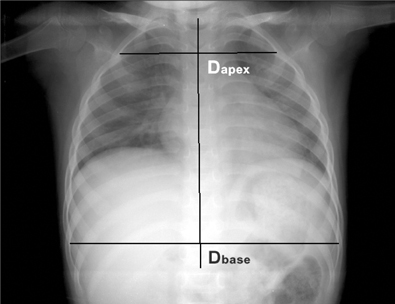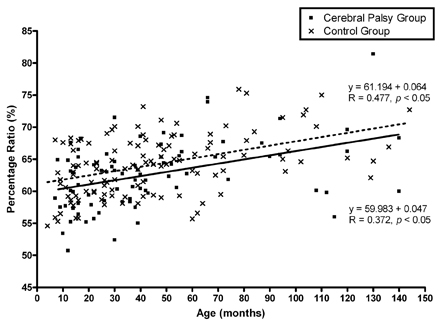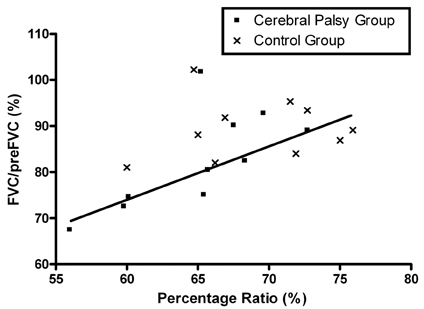Yonsei Med J.
2006 Apr;47(2):237-242. 10.3349/ymj.2006.47.2.237.
Comparison of the Ratio of Upper to Lower Chest Wall in Children with Spastic Quadriplegic Cerebral Palsy and Normally Developed Children
- Affiliations
-
- 1Department and Research Institute of Rehabilitation Medicine, Yonsei University College of Medicine, Korea. pes1234@yumc.yonsei.ac.kr
- 2Brain Korea 21 Project for Medical Science, Yonsei University, Seoul, Korea.
- KMID: 1110748
- DOI: http://doi.org/10.3349/ymj.2006.47.2.237
Abstract
- The upper chest wall does not grow properly in children with spinal muscular atrophy (SMA) with paradoxical breathing. This suggests that long-term inability to take a deep breath in developing children may result in underdevelopment of the upper chest wall. In addition, a rapid and paradoxical breathing pattern is frequently observed in children with severe cerebral palsy (CP), which often corresponds to the underdevelopment of the upper chest wall. The present study is designed to evaluate the ratio of the upper to lower chest wall in children with severe spastic quadriplegic CP, compared with normal children. We compared normal children with children that had spastic quadriplegic CP who did not have kyphosis or scoliosis. Test subjects were matched in terms of age, height, and weight. The diameters of upper chest (D(apex)) and of lower chest (D(base)) were measured on the anteroposterior (AP) view of a chest X-ray and the D(apex) to D(base) ratio was calculated. In selected cases the forced vital capacity (FVC) was measured using a Wright Respirometer. The D(apex) to D(base) ratio was significantly lower in the CP group than in the control group (p < 0.001). The ratio increased linearly with age (p < 0.001) in both CP (R = 0.372) and control groups (R = 0.477). The FVC/preFVC showed significant correlation with the D(apex) to D(base) ratio (R = 0.542, p < 0.01). The results of this study suggest a deviation of optimal chest wall structure in children with spastic quadriplegic CP.
Keyword
MeSH Terms
Figure
Reference
-
1. Strauss D, Cable W, Shavelle R. Causes of excess mortality in cerebral palsy. Dev Med Child Neurol. 1999. 41:580–585.2. Seddon PC, Khan Y. Respiratory problems in children with neurological impairment. Arch Dis Child. 2003. 88:75–78.3. Blumberg ML. Respiration and speech in the cerebral palsied child. AMA Am J Dis Child. 1955. 89:48–53.4. Hardy JC. Lung function of athetoid and spastic quadriplegic children. Dev Med Child Neurol. 1964. 89:378–388.5. Bjure J, Berg K. Dynamic and static lung volumes of school children with cerebral palsy. Acta Paediatr Scand Suppl. 1970. 204:35–41.6. Keesee PD. Abnormal postural reflex activity and voice usage deviations in cerebral palsy. Phys Ther. 1976. 56:1358–1360.7. Benditt JO. Management of pulmonary complications in neuromuscular disease. Phys Med Rehabil Clin North Am. 1998. 9:167–185.8. Redstone F. The effects of seating position on the respiratory patterns of preschoolers with cerebral palsy. Int J Rehabil Res. 2004. 27:283–288.9. Muller H. Finnie NR, editor. Speech. Handling the young child with cerebral palsy at home. 1997. 3rd ed. Oxford: Butterworth-Heinemann;112–117.10. Stamer MH. Posture and movement of the child with cerebral palsy. 2000. San Antonio, Texas: Therapy Skill Builders;79.11. Leopando MT, Moussavi Z, Holbrow J, Chernick V, Pasterkamp H, Rempel G. Effect of a soft Boston orthosis on pulmonary mechanics in severe cerebral palsy. Pediatr Pulmonol. 1999. 28:53–58.12. De Troyer A, Deisser P. The effects of intermittent positive pressure breathing on patients with respiratory muscle weakness. Am Rev Respir Dis. 1981. 124:132–137.13. Estenne M, De Troyer A. The effects of tetraplegia on chest wall statics. Am Rev Respir dis. 1986. 134:121–124.14. Bach JR, Bianchi C. Prevention of pectus excavatum for children with spinal muscular atrophy type 1. Am J Phys Med Rehabil. 2003. 82:815–819.15. Lissoni A, Aliverti A, Molteni F, Bach JR. Spinal muscular atrophy: kinematic breathing analysis. Am J Phys Med Rehabil. 1996. 75:332–339.16. Lissoni A, Aliverti A, Tzeng A, Bach JR. Kinematic analysis of patients with spinal muscular atrophy during spontaneous breathing and mechanical ventilation. Am J Phys Med Rehabil. 1998. 77:188–192.17. Papastamelos C, Panitch HB, England SE, Allen JL. Developmental changes in chest wall compliance in infancy and early childhood. J Appl Physiol. 1995. 78:179–184.18. Goldman MD, Grimby G, Mead J. Mechanical work of breathing derived from rib cage and abdominal V-P partitioning. J Appl Physiol. 1976. 41:752–763.19. Mortola JP, Saetta M, Fox G, Smith B, Weeks S. Mechanical aspects of chest wall distortion. J Appl Physiol. 1985. 59:295–304.20. Guslits BG, Gaston SE, Bryan MH, England SJ, Bryan AC. Diaphragmatic work of breathing in premature human infants. J Appl Physiol. 1987. 62:1410–1415.21. Heldt GP, Mcllroy MB. Distortion of chest wall and work of diaphragm in preterm infants. J Appl Physiol. 1987. 62:164–169.22. Kotagal S, Gibbons VP, Stith JA. Sleep abnormalities in patients with severe cerebral palsy. Dev Med Child Neurol. 1994. 36:304–311.
- Full Text Links
- Actions
-
Cited
- CITED
-
- Close
- Share
- Similar articles
-
- Developmental Delay of Language in Cerebral Palsy Children
- Assessment of Colonic Motility and Nutrients Intake in Children with Spastic Cerebral Palsy
- The Characteristics of Foot Pressure in Children with Mild Spastic Diplegic Cerebral Palsy Related to Medial Arch Formation
- A Survey of Drooling in Children with Cerebral Palsy
- Relation among the Gross Motor Function, Manual Performance and Upper Limb Functional Measures in Children with Spastic Cerebral Palsy




